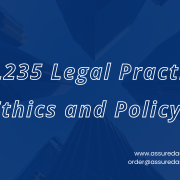Discuss the problem-definition and agenda-setting stages of policymaking.
Problem definition and agenda setting are the common initial moments that are often associated with the decision-making process. It is important to consider that problem definition relies on its interpreters and social construction. It is important to bear in mind that even though the public problems might be many, those that are emphasized are just a few. It is also important to note that public problems often lay out the basis for the decision-makers to come up with relevant policy agenda. Moreover, various factors ought to be considered, especially when policies are formulated. As such, the factors must be given attention in that they are the major determinants of policy proposals. They can play the role of influencing a list by either pushing it forward or obscuring it. Therefore, such factors that tend to influence agendas are considered sources of power that legislators ought to consider. The legislators are the people that are considered those that address problems and develop the relevant solutions (Knill, 2020). Therefore, various competing groups of people tend to engage in the activity of problem identification and solution. Notably, such people who compete to formulate solutions to problems are often grouped following the preferences that include politicians, the mass media, and communities. This essay is concerned with highlighting the major insights associated with the policymaking process.
Several factors ought to be considered when conducting a problem definition process (Seidman, 2016). Notably, to define a problem, one should be in the position of identifying the harm that the problem might lead to. Secondly, one should also be in the position to describe what could lead to the occurrence of the harm. Besides, to understand problem definition, one ought to be in the position of assigning blame to those responsible for the problem’s causation. Moreover, to solve a particular problem, the policymakers should know exactly what the problem entails. They should, therefore, understand the problem in a detailed manner. They also should acknowledge that there are factors that often affect the problem identification process. Therefore, such factors ought to be taken into account when assessing solutions to the problems.
Most importantly, problem-solving is defined as the activity of defining a problem. This is associated with identifying the causes of the problem, the factors affecting the process, and the relevant solutions to the problem. The last step in the process of problem definition is the implementation of the identified alternative solution. On the other side, agenda-setting involves how various actors influence the significance of topics placed in public agendas. Some of the major actors in the agenda-setting activity include the mass media and politicians. It is also important to note that agenda-setting is divided into two, the systemic agenda and the institutional agenda. Notably, systemic agenda refers to societal problems. In contrast, the institutional agenda consists of problems that decision-makers often consider for coming up with the relevant solutions.
Some instances can be used to illustrate and define a public problem. Most importantly, an individual must note that a public problem is a social issue that affects a large group of people. There are many public problems, but only a few are given official attention. As such, an example of a public problem is poverty. It is important to note the fact that poverty tends to affect a large number of people at once. Therefore, policymakers might decide to gather and devise a strategy that will help alleviate the lives of those affected by poverty as a public problem. Notably, there are three common social-economic classes in society, including the rich, middle, and poor. Therefore, the rich might oppress the poverty-solving strategy that might be developed by terming it as unfair treatment.
Policy implementation is the process that is centered around the translation of the goals and objectives of a particular policy into action. Notably, the policy that is often implemented, especially by the government, goes through various stages. The stages range from inception to conclusion. Some of the policy implementation process stages include agenda building, formulating, adoption, implementation, evaluation, and finally, termination. On the other side, the implementation model refers to several components and aspects that can be used to contribute to the implementation of a certain policy. Policy implementation is a stage in the policymaking process where bureaucracies are responsible for announcing a policy. As such, policy implementation is a stage that lies between policymakers and policy addressees. The implementers are the major actors that monitor the policy implementation process. There are three major types of implementation models. The three types are often associated with the theoretical guidelines that can be adopted into the description of policy implementation. The three types include the top-down model, the bottom-up models, and the hybrid models of policy implementation.
The three types of models of policy implementation have both advantages and disadvantages. Notably, the top-down model is considered a traditional approach that deals with the policy outputs and tends to study the extent of the achieved objectives following their time of achievement and means. The preceding model that arose after the top-down model is the bottom-up model of policy implementation that tends to analyze the relevant actors that often take part in the operational level of a particular policy. It is often associated with the stages that revolve around policy creation, implementation, and recreation. The hybrid model is the most recent approach to policy implementation. It is more advanced than the other two models hence more advantageous.
The top-down model of policy implementation is associated with the following advantages. The model is time-saving in that the decisions of the policy implementation process are easy to make. It is, therefore, important when the time is limited. It is a simple model of policy implementation. This is especially because it involves a few people. The demerit of this particular policy implementation model is that there is low and limited participation. As such, the implementation plan tends to be affected negatively. The other shortcoming of the model is that it is associated with a lot of knowledge, more so at the top level. Therefore, it fails to make use of specialized knowledge that might be existing within the lower levels of a particular organization.
The other model of policy implementation is the bottom-up approach. This model benefits from the fact that stakeholders of the policy implementation feel more involved in the policy implementation process. They also feel that they are directly involved with the success of the policy implementation process. If those in the lower levels feel like they are involved in the policy implementation process, they will feel obligated. Hence, they will feel entitled to ownership of the implementation process. The demerit of this particular approach is that there is often a lack of cohesion. This is more so because multiple levels often make decisions. The policy implementation process might, therefore, run without a clear strategy. As such, the complexity of the approach is a shortcoming in that it involves many stakeholders in its decision-making process. The strategy is time-consuming.
Lastly, the hybrid model of policy implementation is advantageous in that it tends to recognize the relevant aspects of both the bottom-up and the top-down models. Therefore, it takes into consideration the significance of the top-down model and the bottom down approach. As such, it has additional theoretical approaches. As such, the model attempts to reduce the time spent and reduce the complexity and maintain simplicity. There are, however, several disadvantages that are associated with the same. The disadvantage of the model includes increased dependency.
References
Knill, C. &. (2020). Public policy: A new introduction. . Red Globe Press.
Seidman, A. (2016). State and law in the development process: problem-solving and institutional change in the Third World. Springer.











